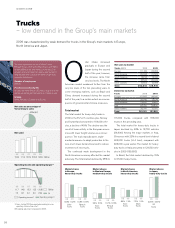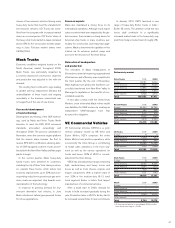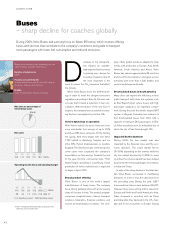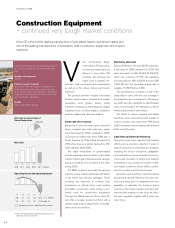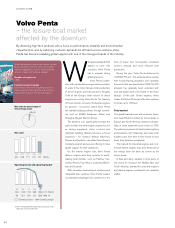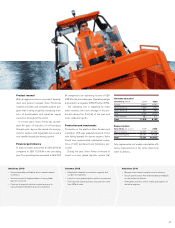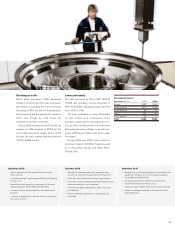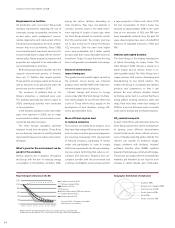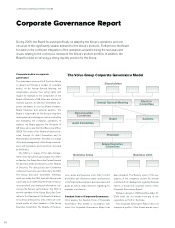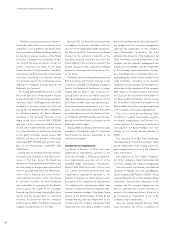Volvo 2009 Annual Report Download - page 52
Download and view the complete annual report
Please find page 52 of the 2009 Volvo annual report below. You can navigate through the pages in the report by either clicking on the pages listed below, or by using the keyword search tool below to find specific information within the annual report.
SEGMENTS 2009
Volvo Aero plays an important part both as a developing and manufacturing partner in the
aircraft engine industry.
Volvo Aero
– contributes to a better environment
through lightweight components
olvo Aero, which is specialized
on the aero engines complex
structures, engine cases and
rotating parts, cooperates with
all major engine manufacturers,
and the company’s engine
components are present in over 90% of all
new, large aircraft.
Highly-interesting technologies
Volvo Aero develops its own unique technolo-
gies which are in increasing demand from cus-
tomers in the aerospace industry. Develop-
ment is mainly concentrated on lightweight
designs, which has tremendous importance
for fuel consumption and emissions. This
makes the technologies highly interesting,
since climate and environmental issues are in
focus. At the same time, it is ever more impor-
tant for airlines to reduce fuel consumption
since fuel accounts for a large part of the total
cost of flying.
Using Volvo Aero’s knowledge of lightweight
design, simulation and new, patented produc-
tion methods, engine manufacturers can
shorten the development process at the same
time as engines become lighter and less noisy.
Many of the technologies are based on com-
petence developed in the military business.
Over time, Volvo Aero has become ever better
at utilizing synergies between military and civil
aviation as well as in the eld of aerospace.
Important events during the year
Volvo Aero secured a vital role in Clean Sky,
EU’s largest aerospace project to date. Volvo
Aero received a role in the subprojects regard-
ing open-rotor engines, which may reduce fuel
consumption by 15 to 20%. The primary objec-
tive of Clean Sky is to develop and test new
engine and component technologies, so that
they are sufciently “mature” to be tested in
commercial engines.
The year 2009 marked a breakthrough for
two new aircraft that will be propelled by Pratt
& Whitney’s new geared turbofan engine,
PW1000G. Volvo Aero takes part in the devel-
opment and manufacturing of the engine.
During 2009, work also continued to develop
components for a new Rolls-Royce, Trent XWB,
for Airbus A350 XWB, according to plan, while
the engine itself was a sales success. The com-
pany has previously received a contract to
develop a vital component for the GP7000
engine for Airbus A380, and at the end of the
year the rst test piece that will deliver lower
weight and increased life for the component
was supplied.
In June, the Swedish government decided
to continue to participate in the European
launch-vehicle program. Thereby Volvo Aero
can continue to participate in all ongoing
Ariane and technology programs and maintain
its leading position in nozzles and turbines for
space rockets. As a result of the decision,
Snecma of France and Volvo Aero agreed on
the basic principles of a ve-year partnership
in the space propulsion eld. Volvo Aero and
Snecma also signed a contract for the supply
of components to the new CFM56 engine for
the Boeing 737 aircraft.
The large investment program in new
machinery in Volvo Aero’s factories, aimed at
shortening lead times and providing a more
robust, exible and efcient production, con-
tinued.
V
4% (2)
Net sales as percentage of Volvo Group sales
1) Years starting 2006 are reported according to a new
reporting structure. See note 7.
Volvo Aero offers advanced components for
aircraft engines and space applications with a
focus on light-weight technology for reduced
fuel consumption. Services for the aerospace
industry are also offered.
Number of employees
2,991
Position on world market
Volvo Aero holds a leading position as an inde-
pendent producer, with engine components in
about 90% of all large commercial aircraft
de livered in 2009.
0908070605
50 SEK M
%
359529359836
0.64.76.94.411.1
Operating income
1
Operating margin
1
Operating income (loss)
and operating margin1
0908070605
7.8 SEK bn7.67.68.27.5
Net sales1
48


